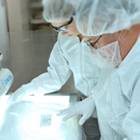spezialf
Artikel-Nr:
(BOSSBS-3619R-HRP)
Lieferant:
Bioss
Hersteller-Artikelnummer::
BS-3619R-HRP
Lokale Artikelnummer::
BOSSBS-3619R-HRP
Beschreibung:
Talin, a multifunctional constituent of cell-substratum attachment sites, is a high molecular weight protein (225-270 kDa) found in variety of tissues and cell types. It is localized at a subset of adherens junctions, specialized cell-cell and cell-matrix associations that are characterized by the presence of filamentous actin at the cytoplasmic face of the junctional complex. In cultured cells, talin is absent from cell-cell junctions and found predominantly at adhesion plaques and in fibrillar streaks underlying cell surface fibronectin. Talin interacts with at least two other proteins that are localized at adhesion plaques, vinculin and integrin. Talin and vinculin have been shown to interact with each other and both have been proposed to be involved in generating the transmembrane connection, between the extracellular matrix and the cytoskeleton, that occurs at adhesion plaques. At physiological ionic strength, talin is an elongate, flexible, monomeric protein with the ability to self-associate into dimers at higher protein concentrations.
VE:
1 * 100 µl
Lieferant:
Biotium
Beschreibung:
Laminins are large hetero-trimeric, non-collagenous glycoproteins composed of α, β, and γ chains. This MAb reacts with laminin B2/1 chain of ~210 kDa and does not cross-react with other basement membrane components or fibronectin. Its specificity was established by immunoprecipitation and immunofluorescence of human skeletal muscle and kidney with laminin chain-specific MAbs. Epithelial sheets in vivo are separated from the mesenchymal elements of the stroma by a thin layer of a specialized type of extracellular matrix termed the basement membrane (BM). This structure consists of individual components, some of which are ubiquitous in BMs and some are not. The ubiquitous ones comprise laminin (LN), entactin/nidogen (EN), collagen type IV (CIV), and large heparan sulfate proteoglycan (HSPG), which interact specifically with each other to form a continuous and regular BM. Alterations of BM integrity, from local discontinuities up to complete loss, are described in many types of human and animal epithelial neoplasms. This MAb stains uniformly all human and murine basement membranes.
Lieferant:
KNAUER
Beschreibung:
Das Knauer Prep LC Premier System ist ein sehr flexibles präparativen Chromatographie System, optimiert für Ihre Synthese- und Reinigungsaufgaben. Das modular aufgebaute System kann leicht an Ihre Applikation und Ansprüche angepasst werden. In der Regel wird die Clarity Prep Software von Dataapex zur Steuerung eingesetzt, ideal für präparativen Arbeit in einem modernen Labor. Um Ihnen einen kurzen Überblick zu geben haben wir 5 fertige Pakete erstellt. Diese Pakete sind der erste Schritt zu Ihrem individuellen Prep LC Premier System.
Lieferant:
BURKLE
Beschreibung:
Manuelle Verdrängerpumpe zum Befüllen, Entleeren und Umfüllen von Flüssigkeiten zwischen Kanistern und Fässern. Der Überdruck wird mit einem manuellen Kolben erzeugt, der die Flüssigkeit aus dem Behälter befördert. Kleine Flüssigkeitsmengen können auch mit dem Ablasshahn abgelassen werden. Die Pumpe wird mit einem flexiblen Stopfen von variablem Durchmesser angebracht. Spezielle Gewindeadapter sind nicht erforderlich.
Lieferant:
Merck
Beschreibung:
Entellan® Neu ist ein neues Eindeckmittel für Eindeckgeräte und auch speziell für gewerbliche Eindeckautomaten geeignet. Seine Viskosität liegt zwischen 250 und 600 mPas; 1,00869 verfügt über einen kleinen Viskositätsbereich. Dieser enge Viskositätsbereich verbessert und beschleunigt die Anwendung, da weder die Tropfrate noch die Menge nach dem ersten Durchlauf mit einer neuen Flasche Entellan® Neu zurückgesetzt werden muss.
Lieferant:
VWR Collection
Beschreibung:
Diese Hosen bestehen zu 99% aus Polyesterfasern und zu 1% aus einem Hydro-Tec Finish. Die nanotechnologische Hydro-Tec-Ausrüstung dieses Spezialstoffs sorgt für eine extreme Haltbarkeit und gute antistatische Eigenschaften. Sie bietet außerdem Schutz vor Schmutz, Öl, Chemikalien und Wasser.
Artikel-Nr:
(BOSSBS-7594R-CY5.5)
Lieferant:
Bioss
Hersteller-Artikelnummer::
BS-7594R-CY5.5
Lokale Artikelnummer::
BOSSBS-7594R-CY5.5
Beschreibung:
Ankyrins are a family of proteins that link the integral membrane proteins to the underlying spectrin-actin cytoskeleton and play key roles in activities such as cell motility, activation, proliferation, contact and the maintenance of specialized membrane domains. Multiple isoforms of ankyrin with different affinities for various target proteins are expressed in a tissue-specific, developmentally regulated manner. Most ankyrins are typically composed of three structural domains: an amino-terminal domain containing multiple ankyrin repeats; a central region with a highly conserved spectrin binding domain; and a carboxy-terminal regulatory domain which is the least conserved and subject to variation. Ankyrin 1, the prototype of this family, was first discovered in the erythrocytes, but since has also been found in brain and muscles. Mutations in erythrocytic ankyrin 1 have been associated in approximately half of all patients with hereditary spherocytosis. Complex patterns of alternative splicing in the regulatory domain, giving rise to different isoforms of ankyrin 1 have been described. Truncated muscle-specific isoforms of ankyrin1 resulting from usage of an alternate promoter have also been identified. [provided by RefSeq, Dec 2008].
VE:
1 * 100 µl
Artikel-Nr:
(BOSSBS-6703R-CY3)
Lieferant:
Bioss
Hersteller-Artikelnummer::
BS-6703R-CY3
Lokale Artikelnummer::
BOSSBS-6703R-CY3
Beschreibung:
Key regulator in endo-lysosomal trafficking. Governs early-to-late endosomal maturation, microtubule minus-end as well as plus-end directed endosomal migration and positioning, and endosome-lysosome transport through different protein-protein interaction cascades. Plays a central role, not only in endosomal traffic, but also in many other cellular and physiological events, such as growth-factor-mediated cell signaling, nutrient-transportor mediated nutrient uptake, neurotrophin transport in the axons of neurons and lipid metabolism. Also involved in regulation of some specialized endosomal membrane trafficking, such as maturation of melanosomes, pathogen-induced phagosomes (or vacuoles) and autophagosomes. Plays a role in the maturation and acidification of phagosomes that engulf pathogens, such as S.aureus and M.tuberculosis. Plays a role in the fusion of phagosomes with lysosomes. Plays important roles in microbial pathogen infection and survival, as well as in participating in the life cycle of viruses. Microbial pathogens possess survival strategies governed by RAB7A, sometimes by employing RAB7A function (e.g. Salmonella) and sometimes by excluding RAB7A function (e.g. Mycobacterium). In concert with RAC1, plays a role in regulating the formation of RBs (ruffled borders) in osteoclasts. Controls the endosomal trafficking and neurite outgrowth signaling of NTRK1/TRKA. Regulates the endocytic trafficking of the EGF-EGFR complex by regulating its lysosomal degradation.
VE:
1 * 100 µl
Artikel-Nr:
(BOSSBS-6703R-CY7)
Lieferant:
Bioss
Hersteller-Artikelnummer::
BS-6703R-CY7
Lokale Artikelnummer::
BOSSBS-6703R-CY7
Beschreibung:
Key regulator in endo-lysosomal trafficking. Governs early-to-late endosomal maturation, microtubule minus-end as well as plus-end directed endosomal migration and positioning, and endosome-lysosome transport through different protein-protein interaction cascades. Plays a central role, not only in endosomal traffic, but also in many other cellular and physiological events, such as growth-factor-mediated cell signaling, nutrient-transportor mediated nutrient uptake, neurotrophin transport in the axons of neurons and lipid metabolism. Also involved in regulation of some specialized endosomal membrane trafficking, such as maturation of melanosomes, pathogen-induced phagosomes (or vacuoles) and autophagosomes. Plays a role in the maturation and acidification of phagosomes that engulf pathogens, such as S.aureus and M.tuberculosis. Plays a role in the fusion of phagosomes with lysosomes. Plays important roles in microbial pathogen infection and survival, as well as in participating in the life cycle of viruses. Microbial pathogens possess survival strategies governed by RAB7A, sometimes by employing RAB7A function (e.g. Salmonella) and sometimes by excluding RAB7A function (e.g. Mycobacterium). In concert with RAC1, plays a role in regulating the formation of RBs (ruffled borders) in osteoclasts. Controls the endosomal trafficking and neurite outgrowth signaling of NTRK1/TRKA. Regulates the endocytic trafficking of the EGF-EGFR complex by regulating its lysosomal degradation.
VE:
1 * 100 µl
Artikel-Nr:
(BOSSBS-7594R-A647)
Lieferant:
Bioss
Hersteller-Artikelnummer::
BS-7594R-A647
Lokale Artikelnummer::
BOSSBS-7594R-A647
Beschreibung:
Ankyrins are a family of proteins that link the integral membrane proteins to the underlying spectrin-actin cytoskeleton and play key roles in activities such as cell motility, activation, proliferation, contact and the maintenance of specialized membrane domains. Multiple isoforms of ankyrin with different affinities for various target proteins are expressed in a tissue-specific, developmentally regulated manner. Most ankyrins are typically composed of three structural domains: an amino-terminal domain containing multiple ankyrin repeats; a central region with a highly conserved spectrin binding domain; and a carboxy-terminal regulatory domain which is the least conserved and subject to variation. Ankyrin 1, the prototype of this family, was first discovered in the erythrocytes, but since has also been found in brain and muscles. Mutations in erythrocytic ankyrin 1 have been associated in approximately half of all patients with hereditary spherocytosis. Complex patterns of alternative splicing in the regulatory domain, giving rise to different isoforms of ankyrin 1 have been described. Truncated muscle-specific isoforms of ankyrin1 resulting from usage of an alternate promoter have also been identified. [provided by RefSeq, Dec 2008].
VE:
1 * 100 µl
Artikel-Nr:
(BOSSBS-2506R-CY3)
Lieferant:
Bioss
Hersteller-Artikelnummer::
BS-2506R-CY3
Lokale Artikelnummer::
BOSSBS-2506R-CY3
Beschreibung:
Water is a critical component of all living cells. Interestingly, tissue membranes show a great degree of water permeability. Mammalian red cells, renal proximal tubules, and descending thin limb of Henle are extraordinarily permeable to water. Water crosses hydrophobic plasma membranes either by simple diffusion or through a facilitative transport mechanism mediated by special protein "aquaporin". Over the last decade, genes for several members of aquaporin family have been cloned, expressed, and their distribution studied in many tissues. AQP0 or MIP26 (major intrinsic protein 26kD), and Aquaporin 1 (AQP1, purified from red cells) also called CHIP28 (channel forming integral protein, 28kD; 268aa; gene locus 7p14) has been the foundation of the growing family of aquaporin. The lens specific AQP0 represents up to 80% of total lens membrane protein. Defects in MIP26 are cause of autosomal dominant cataract. The cataract Fraser mutation (CATFR or Shriveled) is a transposon induced splicing error that substitutes a long terminal repeat sequence for the C terminus of MIP. The lens opacity mutation (LOP) is an amino acid substitution that inhibits targeting of MIP to the cell membrane.
VE:
1 * 100 µl
Artikel-Nr:
(BOSSBS-2506R-CY5.5)
Lieferant:
Bioss
Hersteller-Artikelnummer::
BS-2506R-CY5.5
Lokale Artikelnummer::
BOSSBS-2506R-CY5.5
Beschreibung:
Water is a critical component of all living cells. Interestingly, tissue membranes show a great degree of water permeability. Mammalian red cells, renal proximal tubules, and descending thin limb of Henle are extraordinarily permeable to water. Water crosses hydrophobic plasma membranes either by simple diffusion or through a facilitative transport mechanism mediated by special protein "aquaporin". Over the last decade, genes for several members of aquaporin family have been cloned, expressed, and their distribution studied in many tissues. AQP0 or MIP26 (major intrinsic protein 26kD), and Aquaporin 1 (AQP1, purified from red cells) also called CHIP28 (channel forming integral protein, 28kD; 268aa; gene locus 7p14) has been the foundation of the growing family of aquaporin. The lens specific AQP0 represents up to 80% of total lens membrane protein. Defects in MIP26 are cause of autosomal dominant cataract. The cataract Fraser mutation (CATFR or Shriveled) is a transposon induced splicing error that substitutes a long terminal repeat sequence for the C terminus of MIP. The lens opacity mutation (LOP) is an amino acid substitution that inhibits targeting of MIP to the cell membrane.
VE:
1 * 100 µl
Artikel-Nr:
(BOSSBS-11988R-CY5)
Lieferant:
Bioss
Hersteller-Artikelnummer::
BS-11988R-CY5
Lokale Artikelnummer::
BOSSBS-11988R-CY5
Beschreibung:
Brain-specific neurabin I (neural tissue-specific F-actin binding protein I) is highly concentrated in the synapse of developed neurons; it localizes in the growth cone lamellipodia during neuronal development (1). Suppression of endogenous neurabin in rat hippocampal neurons inhibits neurite formation (1). Neurabin I recruits active PP1 via a PP1-docking sequence; mutation of the PP1-binding motif halts filopodia and restores stress fibers in neurabin I-expressing cells (2,3). Neurabin II (Spinophilin) is ubiquitously expressed but is abundantly expressed in brain (4). Neurabin II localizes to neuronal dentritic spines, which are the specialized protrusions from dendritic shafts that receive most of the excitatory input in the CNS (5). Neurabin II may regulate dendritic spine properties as neurabin II(-) mice have increased spine density during development in vitro and exhibit altered filopodial formation in cultured cells (5). Neurabin may also play a role in glutamatergic transmission as Neurabin II(-) mice exhibit reduced long-term depression and resistance to kainate-induced seizures and neronal apoptosis (5). Neurabin II complexes with the catalytic subunit of protein phosphatase-1 (PP1) in vitro thus modulating the activity of PP1 (4).
VE:
1 * 100 µl
Artikel-Nr:
(113-0494)
Lieferant:
DuPont
Hersteller-Artikelnummer::
TYPS32SWH00020
Lokale Artikelnummer::
DUPOTYPS32SWH00020
Beschreibung:
Als Ergänzung zu Tyvek® Schutzkleidung können diese Tyvek® Armstulpen dazu beitragen, besonders exponierte Körperteile noch besser zu schützen. Tyvek® besteht aus sehr feinen, versponnenen Endlosfasern aus Polyethylen hoher Dichte, das eine ideale Kombination aus Schutz, Haltbarkeit und Tragekomfort bietet.
VE:
1 * 200 ST
Artikel-Nr:
(BOSSBS-7594R-CY7)
Lieferant:
Bioss
Hersteller-Artikelnummer::
BS-7594R-CY7
Lokale Artikelnummer::
BOSSBS-7594R-CY7
Beschreibung:
Ankyrins are a family of proteins that link the integral membrane proteins to the underlying spectrin-actin cytoskeleton and play key roles in activities such as cell motility, activation, proliferation, contact and the maintenance of specialized membrane domains. Multiple isoforms of ankyrin with different affinities for various target proteins are expressed in a tissue-specific, developmentally regulated manner. Most ankyrins are typically composed of three structural domains: an amino-terminal domain containing multiple ankyrin repeats; a central region with a highly conserved spectrin binding domain; and a carboxy-terminal regulatory domain which is the least conserved and subject to variation. Ankyrin 1, the prototype of this family, was first discovered in the erythrocytes, but since has also been found in brain and muscles. Mutations in erythrocytic ankyrin 1 have been associated in approximately half of all patients with hereditary spherocytosis. Complex patterns of alternative splicing in the regulatory domain, giving rise to different isoforms of ankyrin 1 have been described. Truncated muscle-specific isoforms of ankyrin1 resulting from usage of an alternate promoter have also been identified. [provided by RefSeq, Dec 2008].
VE:
1 * 100 µl
Artikel-Nr:
(7520-94)
Lieferant:
Avantor
Lokale Artikelnummer::
BAKR7520-94
Beschreibung:
Bei den SPE-12G PTFE-Säulenprozessoren handelt es sich um Vakuumkammern (spezielles PTFE-Design), die es ermöglichen, 12 Proben gleichzeitig laufen zu lassen. Bei einem Experiment wird damit die Flexibilität gewährleistet, mit SPE-Geräten zu arbeiten, die verschiedene Höhen, Durchmesser oder Formate aufweisen. Mit einer Vakuumkammer aus Borosilikatglas, einem weißen Deckel aus Polyamid inkl. 12 PTFE-Luer-Anschlüssen, Stöpseln (12 St.) für den Deckel, einer PE-Dichtung, 12 PP-Luer-Hähnen und einem PTFE-Probensammelgestell.
VE:
1 * 1 ST
Preis auf Anfrage
Lager für diesen Artikel ist begrenzt, kann aber in einem Lagerhaus in Ihrer Nähe zur Verfügung. Bitte stellen Sie sicher, dass Sie in sind angemeldet auf dieser Seite, so dass verfügbare Bestand angezeigt werden können. Wenn das
Lager für diesen Artikel ist begrenzt, kann aber in einem Lagerhaus in Ihrer Nähe zur Verfügung. Bitte stellen Sie sicher, dass Sie in sind angemeldet auf dieser Seite, so dass verfügbare Bestand angezeigt werden können. Wenn das
Dieses Produkt kann nur an eine Lieferadresse versandt werden die über die entsprechende Lizenzen verfügt. Für weitere Hilfe bitte kontaktieren Sie Ihr VWR Vertriebszentrum.
-Additional Documentation May be needed to purchase this item. A VWR representative will contact you if needed.
Dieses Produkt wurde von Ihrer Organisation gesperrt. Bitte kontaktieren Sie Ihren Einkauf für weitere Informationen.
Dieses Produkt ist Ersatz für den von Ihnen gewünschten Artikel.
Dieses Produkt ist nicht mehr verfügbar. Bitte kontaktieren Sie den VWR Kundenservice.
|
|||||||||

















































